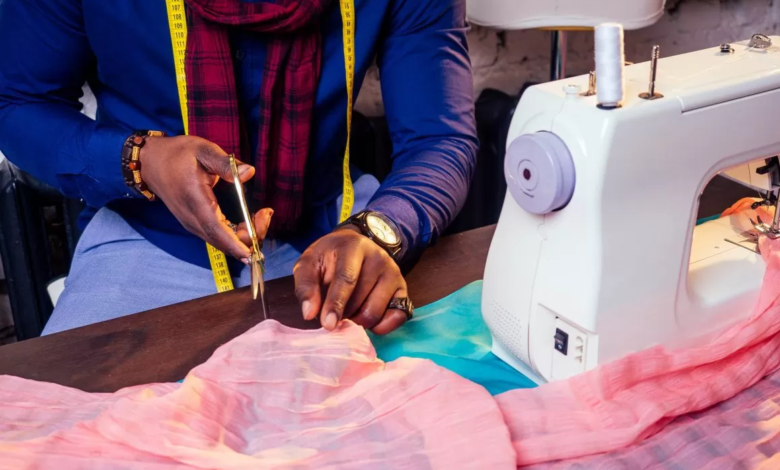10 Ways On How To Become A Successful Tailor – Ankarawears Review on Good Tailor
How Do I Become A Good Tailor? Check 10 Ways To Be Successful Tailor

What makes a tailor successful? If you’re aspiring to become a tailor or find yourself uncertain about how to embark on this journey, you’ve landed on the right page. Let’s navigate the path together and guide you towards a successful start in the world of tailoring.”
Ankarawears Reviews is your go-to source for in-depth insights into fashion, particularly because we focus on Ankara wear and other trendy styles.
Many tailors and seamstresses have reached out to us, asking for guidance on their tailoring journey. So, we’ve put together easy-to-read content covering important topics like what makes a tailor successful and how to become a good tailor.
This content is for all tailors and seamstresses out there. Prepare to be informed and inspired as we not only provide reviews but also share valuable lessons on what makes a tailor successful and guide you on the journey to becoming a skilled and accomplished tailor. Stay tuned for a blend of fashion exploration and practical tips!”
Tailor’s Success and Tips on Becoming a Skilled Professional
Success as a tailor can be influenced by a combination of technical skills, business acumen, customer service, and creativity. Here are some key factors to a tailor’s success and tips on becoming a skilled professional which are.
- Technical Skills:
- Creativity:
- Customer Service:
- Business Acumen:
- Time Management:
- Continuous Learning:
- Ethical Practices:
- Networking
- Quality of Work
- Adaptability to Technology:
Tailor Technical skills
Technical skills are the specific abilities and knowledge that a tailor needs to excel in their craft. In the context of tailoring, technical skills encompass various aspects. Let’s delve deeper into the key technical skills required for what makes a tailor successful:
- Precision and Accuracy:
- Successful tailors excel in precision and accuracy. This involves mastery in sewing and cutting techniques to guarantee that garments fit flawlessly. Whether it’s creating seams, hems, or intricate designs, precision is crucial for delivering a polished final product.
- Knowledge of Fabrics:
- Understanding the diverse range of fabrics and their unique characteristics is fundamental for a skilled tailor. Different fabrics behave differently, and a tailor’s ability to work with various materials ensures the creation of high-quality garments. This includes knowing how different fabrics drape, stretch, and react to various sewing techniques.
- Pattern Making:
- Pattern-making is a specialized skill that involves creating templates for cutting fabric pieces to be sewn together. Tailors proficient in pattern-making can design or modify garments to meet specific requirements. This skill requires a keen understanding of garment construction and the ability to translate design concepts into tangible patterns.

Tailor Creativity
Creativity is a crucial aspect that goes beyond the technical skills of sewing and crafting garments/clothing. It involves bringing a unique and innovative perspective to the design process, allowing tailors to produce distinctive and aesthetically pleasing clothing. Here are two key elements of creativity in tailoring:
- Developing a Good Eye for Design and Style:
- Attention to Detail: A creative tailor pays close attention to the details of design. This includes understanding garment structure, fabric properties, color combinations, and how different elements come together to create a visually appealing piece.
- Understanding Proportions: A good eye for design involves an understanding of proportions and how they affect the overall look of a garment. This includes considering the body shape of the wearer and ensuring that the clothing enhances its features.
- Knowledge of Design Principles: Creativity in tailoring is grounded in a solid understanding of design principles such as balance, harmony, rhythm, and emphasis. Applying these principles helps create well-balanced and aesthetically pleasing garments.
- Staying Open to New Trends and Ideas:
- Continuous Learning: Fashion is constantly evolving, and creative tailors stay informed about the latest trends and innovations in the industry. This involves continuous learning and keeping up with fashion shows, industry publications, and emerging designers.
- Adaptability: Creativity in tailoring also means being adaptable and willing to embrace new ideas. Tailors should be open to incorporating contemporary styles and techniques into their work, while also adding their unique twist to stay original.
- Customer Preferences: Understanding and incorporating customer preferences is a key aspect of staying open to new ideas. Creative tailors listen to their clients, interpret their style preferences, and translate them into reality.
Customer Service in Tailoring:
- Effective Communication with Clients:
- Listening Skills: Customer service in tailoring begins with attentive listening. Understanding clients’ preferences, styles, and specific requirements is crucial.
- Clear Communication: Tailors must convey information clearly, discussing design options, fabric choices, and any alterations to ensure the client’s vision is accurately captured.
- Timely Updates: Keeping clients informed about the progress of their clothing fosters trust and demonstrates a commitment to excellent service.
- Attention to Detail for Customer Satisfaction:
- Precision in Measurements: Accurate measurements are fundamental to well-fitted Clothing. Tailors must pay meticulous attention to ensure every measurement is precise.
- Quality Craftsmanship: Upholding high standards in sewing and clothing construction reflects the tailor’s commitment to delivering quality products that meet or exceed customer expectations.
- Thorough Follow-Up: After the initial fitting, follow-up sessions and adjustments are essential. This meticulous approach ensures the final product aligns perfectly with the client’s preferences
Business Acumen in Tailoring:
Business acumen in tailoring involves not only delivering exceptional work but also effectively marketing services to attract and retain customers.
- Effectively Market Services:
- Targeted Promotion: Identify and target specific customer segments through tailored marketing strategies. This may include digital marketing, social media, and collaborations with fashion influencers.
- Showcase Expertise: Highlighting the tailor’s skills, unique design approach, and successful past projects helps build a strong brand image.
- Customer Testimonials: Positive feedback and testimonials from satisfied clients serve as powerful marketing tools, instilling confidence in potential customers.
- Manage Finances Wisely, Including Pricing:
- Cost Analysis: Conduct a thorough analysis of material costs, labor, and overhead expenses. Understanding the cost structure is crucial for setting competitive yet profitable prices.
- Value-Based Pricing: Consider the value provided to customers when determining pricing. Quality craftsmanship, personalized service, and unique designs contribute to the perceived value of the tailoring services.
- Regular Financial Review: Regularly review financial statements to track income, expenses, and profitability. This allows for informed decision-making and adjustments to business strategies as needed.
Time Management in Tailoring:
- Prioritization of Tasks:
- Identify Critical Steps: Break down the tailoring process into essential steps and prioritize them based on their impact on the overall project.
- Deadline Awareness: Set realistic deadlines for each phase of the project and consistently monitor progress to ensure timely completion.
Continuous Learning In Tailoring
Continuous learning refers to the ongoing process of acquiring new knowledge, and skills and staying informed about industry trends and advancements. Tailors who embrace continuous learning are committed to staying adaptable and enhancing their expertise throughout their careers.
- Adaptability: Being open to trying new things and adjusting your techniques to keep up with changes in fashion and customer preferences.
- Skill Improvement: Always looking for ways to get better at what you do, whether it’s learning new sewing methods or keeping up with the latest fabric trends.
- Following Fashion Trends: Keeping an eye on what’s popular in fashion so you can offer your customers modern and stylish options.
- Using Technology: Embracing new tools and machines that can make your work easier and more efficient.
Related Content For You:
- 10+ Female Ankara Styles Of Beautiful Photos For You
- Elevate Your Wardrobe with Eye-Catching Ankara Short Knickers!
- Check Out For Handsome Guys who Established Ankara Styles For Men
Ethical Practices In Tailoring
Ethical practices involve building trust with your customers through honesty and reliability. Here’s a simple and easy-to-understand explanation:
-
- Honesty: Be truthful and transparent with your customers. If there are limitations or considerations with a garment, let them know. Honest communication builds trust and helps customers make informed decisions.
- Reliability: Deliver on your promises and meet deadlines. If you commit to a certain delivery date or specific features in a garment, make sure you follow through. Reliability demonstrates professionalism and fosters trust with your customers.
Networking In Tailoring
Networking is about making friends and connections in the tailoring world. By doing so, you open doors to opportunities, collaborations, and a stronger presence in the industry
- Building Relationships: Connect with other tailors, suppliers, and professionals in the fashion industry. Attend events, join online groups, and participate in activities where you can meet and interact with others in your field.
- Positive Interactions: Approach networking with a friendly and positive attitude. Be open to sharing your experiences and learning from others. Positive interactions can lead to collaborations, referrals, and a supportive network.
Quality of Work In Tailoring
Ensuring the quality of work in tailoring means consistently delivering high-quality craftsmanship.
- Consistent Excellence: Strive to produce garments that are well-made and meet high standards every time. Pay attention to details, use quality materials, and ensure that each piece reflects your best work.
- Craftsmanship: Take pride in your craft. Pay careful attention to the sewing, stitching, and finishing touches of every garment you create. Quality craftsmanship is a hallmark of a skilled tailor.
As you navigate through this app, grab some key lessons on what makes a tailor successful. We’re thrilled to have you on board, and we hope you find these insights a valuable addition to your skill set. Don’t forget to share this useful information with your friends on Facebook, Twitter, and Google+ using the share buttons below.



